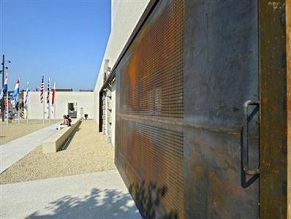|
World Jewish News

A white building, austere and massive, with mural windows, the 25,852 bricks used in its construction represent the number of Jews and gypsies sent to their deaths at Auschwitz from the nearby barracks, only metres from site of the museum.
|
Belgian King opens new Holocaust museum on former Auschwitz deportation site
27.11.2012, Holocaust King Albert II of Belgium on Monday inaugurated the Museum of the Holocaust and Human Rights opposite the “Dossin Barracks”, in Mechelen, the site from which more than 25,000 Jews were deported to Auschwitz death camp, along with 352 gypsies between 1942-1944.
Named “Dossin Barracks Memorial, Museum and Documentation Centre for the Holocaust and Human Rights”, the building is housed close to the centre of Mechelen, some 30 kilometres north of Brussels.
The newly-built cubic building, which was built according to the blueprints of noted Flemish architect Bob Van Reeth and financed by Flemish authorities, will be open to the public from December 1.
A white building, austere and massive, with mural windows, the 25,852 bricks used in its construction represent the number of Jews and gypsies sent to their deaths at Auschwitz from the nearby barracks, only metres from site of the museum.
The Belgian equivalent of the French Drancy camp, outside of Paris, the Dossin barracks, an 18th century building whose courtyards connected directly to the Belgian rail network, was used as a transit camp by Nazi occupiers between 1942-1944 for deportations to the Auschwitz-Birkenau camp.
Chosen deportees generally stayed two or three months in the barracks before being transferred to the German concentration camp in cattle wagons. Only 5% of Jews and gypsies transferred in the 28 separate deportations survived the end of the war, returning home in 1945.
In September the Belgian Prime Minster Elio Di Rupo offered his apologies on behalf of Belgium for the role of its wartime administration in the deportation of its Jewish community.
“Today, Flanders looks its wartime past in the face,” asserted the museum’s curator, Professor Herman Van Goethem, revealing that “witnesses” of Belgium’s Nazi collaboration were less and less numerous in the Dutch-Belgian region.
In 1995, at the initiative of the Jewish community, a “Jewish Museum of the Deportation and Resistance” was opened on the site. But it soon proved too small and could house considerably fewer visitors than the new memorial.
Only the fourth floor of the museum, home to temporary exhibitions has access to natural daylight, with the three lower floors constituting a sort of opaque mausoleum. Rectangular reinforcements in the building’s white facade are designed to symbolise mural windows and steel sliding doors of the deportation wagons. “The total volume corresponds to that of the wagons used for the 28 deportations,” explained the architect.
Following an introductory film, a tour was conducted in three stages.
The ground floor, entitled “mass”, shows how the crowds were carried away with anti-Semitic sentiment, fear and rejection of others, and finally acceptance of the reversal of the most fundamental freedoms.
The aim to be promoted to future visitors, which will include numerous school students, is to draw parallels with the present day, without denying the uniqueness of the Holocaust, seen especially through their eyes.
The second floor evokes “the anguish” of the occupation, through thousands of photos, witness statements and police reports.
The best part is provided by modern technology, in particular touch screens, which allow visitors to explore the moving school records of a Jewish child, as well as hearing the testimony of a man who escaped a Nazi raid.
On the third and only remaining level, the visitor is confronted by “death”, conveyed by photos of women and children en route to Nazi gas chambers and portraits of murdered families.
EJP
|
|
